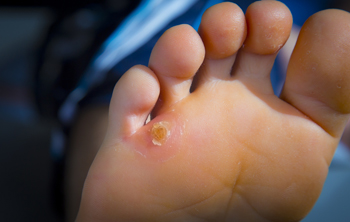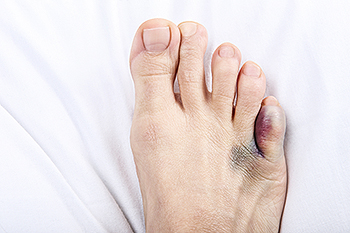Items filtered by date: January 2025
Ankle Pain and Pickleball

Ankle pain has become increasingly common in the growing sport of pickleball, particularly among the aging population. The fast-paced, high-intensity movements required in the game, such as abrupt direction changes, quick pivots, and sudden stops, can put significant stress on the ankles. As people age, the tendons and ligaments around the ankle become less flexible and more prone to strain, making them more susceptible to injury. The risk of ankle pain is further heightened by wearing improper footwear, such as shoes that lack adequate support or cushioning. The combination of these factors can lead to sprains, strains, and even more serious injuries, such as ligament tears or fractures. Proper warm-up, strength training, and wearing shoes specifically designed for the sport can help reduce the risk of ankle pain. If you have ankle pain from playing pickleball, it is suggested that you consult a podiatrist who can offer effective relief tips, and guide you ankle injury prevention techniques while playing this popular game.
Ankle pain can be caused by a number of problems and may be potentially serious. If you have ankle pain, consult with one of our podiatrists from CyFair Family Foot Care. Our doctors will assess your condition and provide you with quality foot and ankle treatment.
Ankle pain is any condition that causes pain in the ankle. Due to the fact that the ankle consists of tendons, muscles, bones, and ligaments, ankle pain can come from a number of different conditions.
Causes
The most common causes of ankle pain include:
- Types of arthritis (rheumatoid, osteoarthritis, and gout)
- Ankle sprains
- Broken ankles
- Achilles tendonitis
- Achilles tendon rupture
- Stress fractures
- Bursitis
- Tarsal tunnel syndrome
- Plantar fasciitis
Symptoms
Symptoms of ankle injury vary based upon the condition. Pain may include general pain and discomfort, swelling, aching, redness, bruising, burning or stabbing sensations, and/or loss of sensation.
Diagnosis
Due to the wide variety of potential causes of ankle pain, podiatrists will utilize a number of different methods to properly diagnose ankle pain. This can include asking for personal and family medical histories and of any recent injuries. Further diagnosis may include sensation tests, a physical examination, and potentially x-rays or other imaging tests.
Treatment
Just as the range of causes varies widely, so do treatments. Some more common treatments are rest, ice packs, keeping pressure off the foot, orthotics and braces, medication for inflammation and pain, and surgery.
If you have any questions, please feel free to contact our offices located in Cypress and Spring, TX . We offer the newest diagnostic and treatment technologies for all your foot care needs.
Causes of Ankle Swelling Without Injury

Ankle swelling can occur even in the absence of an injury and may be a sign of an underlying health condition. One common cause is poor circulation, which can lead to fluid buildup in the lower extremities. Prolonged sitting or standing, especially for long periods, can also result in ankle swelling. Certain medical conditions, such as heart, liver, or kidney disease, can impair the body's ability to regulate fluid, causing swelling in the ankles and other parts of the body. Additionally, high blood pressure or varicose veins can contribute to fluid retention and swelling in the ankles. Hormonal changes, particularly during pregnancy or menstruation, can also lead to ankle swelling due to changes in fluid balance. Additionally, medications, such as those for high blood pressure or diabetes, may have side effects that result in swollen ankles. If ankle swelling persists or is accompanied by other symptoms, it is suggested that you consult a podiatrist who can determine what the cause is, and offer appropriate treatment solutions.
Swollen feet can be a sign of an underlying condition. If you have any concerns, contact one of our podiatrists of CyFair Family Foot Care. Our doctors can provide the care you need to keep you pain-free and on your feet.
Swollen feet are a common ailment among pregnant women and people who stand or sit for extended periods. Aging may increase the possibility of swollen feet and patients who are obese often notice when their feet are swelling too. There may be medical reasons why swollen feet occur:
- Phlebitis - A condition that causes the veins to become inflamed and can also cause leg pain.
- Liver disease - This may lead to low blood levels of albumin which is a protein. This can cause fluid in the blood to pass into the tissues and several areas of the body can become swollen.
- Heart failure - When the heart doesn’t pump properly the blood that is normally pumped back to the heart can pool in the veins of the legs causing swollen feet.
- Kidney disease - One of the main functions of the kidneys is releasing excess fluid in the body. This type of condition can make it difficult for the kidneys to function properly, and as a result the feet may become swollen.
- Deep-vein thrombosis (DVT)- This is a serious condition where blood clots form in the veins of the legs. They can block the return of blood from the legs to the heart which may cause the feet to swell. It is important to be treated by a podiatrist if this condition is present.
Swollen feet can also be caused by bone and tendon conditions, including fractures, arthritis, and tendinitis. Additionally, there may be skin and toenail conditions and an infection may cause the feet to swell. Patients who take medicine to treat high blood pressure may be prone to getting swollen feet.
Many patients elevate their feet to help relieve the swelling and this is generally a temporary remedy. When a podiatrist is consulted the reason behind the swelling can be uncovered and subsequently treated.
If you have any questions please feel free to contact our offices located in Cypress and Spring, TX . We offer the newest diagnostic tools and technology to treat your foot and ankle needs.
Are Bunions Affecting Your Everyday Life?
Causes and Symptoms of Foot Corns

Foot corns are thickened areas of skin that develop on the feet due to repeated friction or pressure. They typically form on the tops, sides, or between the toes from wearing ill-fitting shoes that rub against the skin. The friction causes the skin to harden in response, forming a corn. Corns can also develop due to abnormal foot mechanics, such as having a toe that constantly rubs against the inside of a shoe. Symptoms of foot corns include pain, tenderness, and visible thickened skin that may have a central hard core. The skin around the corn can become inflamed and irritated, causing discomfort when walking. While corns are not usually serious, they can be painful and may lead to further foot problems if not treated properly. If you have developed a foot corn, it is suggested that you consult a podiatrist who can safely treat this uncomfortable condition.
If you have any concerns regarding your feet and ankles, contact one of our podiatrists of CyFair Family Foot Care. Our doctors will treat your foot and ankle needs.
Corns: What Are They? and How Do You Get Rid of Them?
Corns can be described as areas of the skin that have thickened to the point of becoming painful or irritating. They are often layers and layers of the skin that have become dry and rough, and are normally smaller than calluses.
Ways to Prevent Corns
There are many ways to get rid of painful corns such as wearing:
- Well-fitting socks
- Comfortable shoes that are not tight around your foot
- Shoes that offer support
Treating Corns
Treatment of corns involves removing the dead skin that has built up in the specific area of the foot. Consult with Our doctors to determine the best treatment option for your case of corns.
If you have any questions please feel free to contact our offices located in Cypress and Spring, TX . We offer the newest diagnostic and treatment technologies for all your foot and ankle needs.
Why Does My Pinky Toe Hurt?

Pinky toe pain can be caused by a variety of factors, often resulting from injury, pressure, or underlying medical conditions. One common cause is wearing tight or ill-fitting shoes, which put pressure on the pinky toe and lead to pain, blisters, or even bunions. Another potential cause is a stubbed toe or trauma to the foot, resulting in bruising or swelling. Conditions like hammertoe or gout can also lead to discomfort in the pinky toe, causing it to become stiff, inflamed, or deformed. Symptoms of pinky-toe pain include aching, swelling, redness, and difficulty moving the toe. In more severe cases, the toe may appear bruised, crooked, or misaligned. If the pain persists or worsens, it is suggested that you consult a podiatrist to determine the underlying cause and receive appropriate treatment to manage the symptoms and prevent further issues.
Toe pain can disrupt your daily activities. If you have any concerns, contact one of our podiatrists of CyFair Family Foot Care. Our doctors can provide the care you need to keep you pain-free and on your feet.
What Causes Toe Pain?
Most severe toe pain is caused due to a sports injury, trauma from dropping something heavy on the toe, or bumping into something rigid. Other problems can develop over time for various reasons.
Toe pain can be caused by one or more ailments. The most common include:
- Trauma
- Sports injury
- Wearing shoes that are too tight
- Arthritis
- Gout
- Corns and calluses
- Hammertoe
- Bunions
- Blisters
- Ingrown toenails
- Sprains
- Fractures (broken bones)
- Dislocations
When to See a Podiatrist
- Severe pain
- Persistent pain that lasts more than a week
- Signs of infection
- Continued swelling
- Pain that prevents walking
Diagnosis
In many cases the cause of toe pain is obvious, but in others, a podiatrist may want to use more advanced methods to determine the problem. These can range from simple visual inspections and sensation tests to X-rays and MRI scans. Prior medical history, family medical history, and any recent physical traumatic events will all be taken into consideration for a proper diagnosis.
Treatment
Treatments for toe pain and injuries vary and may include shoe inserts, padding, taping, medicines, injections, and in some cases, surgery. If you believe that you have broken a toe, please see a podiatrist as soon as possible.
If you have any questions please feel free to contact our offices located in Cypress and Spring, TX . We offer the newest diagnostic tools and technology to treat your foot and ankle needs.

